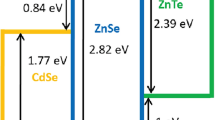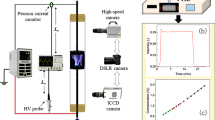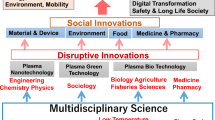Abstract
This study was carried out to investigate and compare gas discharge–semiconductor systems (GDSS) operating under direct-current (DC) and alternating-current (AC) modes for any contribution toward improving energy conversion efficiency. Nonthermal micro plasma discharge systems with novel pattern recognition solutions have received scientific attention due to the rapid technological innovation and faster resolution of complicated problems in computing technology. In the scope of this study, AC-driven discharges using argon gas at atmospheric pressure (760 Torr) were modeled and simulated at 50 Hz and 20 kHz pulse rates generated by a 1.0 kV amplitude power source. DC-driven discharges using argon gas at various sub-atmospheric pressures from 10 Torr up to 760 Torr were also modeled and simulated in the GDSS cell to which a high-ohmic semi-insulating gallium arsenide (GaAs) electrode material was coupled. Gallium arsenide compound semiconductor material has been widely used in optoelectronics due to its high electron mobility and direct narrow band gap properties. DC- and AC-driven micro plasmas were numerically analyzed using the COMSOL Multiphysics simulation program in two-dimensional media. Simulation results in a set of surface and multiple-line graph media were deeply evaluated and reported based on the time-dependent computations of various discharge parameters including mean electron energy, migrative electron flux, surface charge density, space charge density, and surface electron current density for both DC- and AC-driven dielectric barrier discharge (DBD) micro plasma modes. It was observed that highly recognizable unique micro plasma pattern formations can be controlled on a large scale by varying the discharge key parameters and driving modes.











Similar content being viewed by others
Data Availability
The data that support the findings of this study are available on request from the corresponding author.
References
A. Nakao, Y. Tanaka, and A. Ide-Ektessabi, Discharge properties of a micro plasma cell with an MgO–NiO protecting layer. Surf. Coat. Technol. 203(17–18), 2731 (2009).
Y. Song, K. Choi, D.H. Jun, and J. Oh, Nanostructured GaAs solar cells via metal-assisted chemical etching of emitter layers. Opt. Express 25(20), 23862 (2017).
R.C. Knechtli, R.Y. Loo, and G.S. Kamath, High-efficiency GaAs solar cells. IEEE Trans. Electron Devices 31(5), 577 (1984).
P.A. Iles, Photovoltaic conversion: space applications. Encycloped. Energy. 5, 25 (2004).
Y.Y. Peter, M. Cardona, Fundamentals of Semiconductors: Physics and Materials Properties. Springer-Verlag Berlin Heidelberg, 4th edition, eBook ISBN 978-3-642-00710-1 (2010)
O. Madelung, Semiconductors: Data Handbook. Springer Berlin Heidelberg, 3rd edition, eBook ISBN 978-3-642-18865-7 (2012)
A. Rogalski, Infrared Detectors. CRC press, 2nd edition, https://doi.org/10.1201/b10319 (2010).
H.H. Kurt and E. Tanrıverdi, The features of GaAs and GaP semiconductor cathodes in an infrared converter system. J. Electron. Mater. 46, 4024 (2017).
Yu.A. Astrov, A.N. Lodygin, and L.M. Portsel, Dynamics and stability of the Townsend discharge in nitrogen in narrow gaps. Phys. Rev. E 89, 033109 (2014).
R.A. Meyers, Encyclopedia of Physical Science and Technology. Academic Press 3rd edition, ISBN-13: 978-0122274107 (2001).
F.H. Raab, P. Asbeck, S. Cripps, P.B. Kenington, Z.B. Popovic, N. Pothecary, J.F. Sevic, and N.O. Sokal, RF and microwave power amplifier and transmitter technologies—part 1. High Frequency Electron. 2, 22 (2003).
B.L. Markham, T. Arvidson, J.A. Barsi, M. Choate, E. Kaita, R. Levy, J.G. Masek, Landsat program Comprehensive remote sensing. Reference Module in Earth Systems and Environmental Sciences. 1, 27,1 (2017)
M. Kondow, T. Kitatani, S. Nakatsuka, M.C. Larson, K. Nakahara, Y. Yazawa, M. Okai, and K. Uomi, GaInNAs: a novel material for long-wavelength semiconductor lasers. IEEE J. Sel. Top. Quantum Electron. 3(3), 719 (1997).
T.M. Khan, S.U.-D. Khan, M. Raffi, and R. Khan, Theoretical–computational study of atmospheric DBD plasma and its utility for nanoscale biocompatible plasmonic coating. Molecules 26(16), 5106 (2021).
A.L. Garner, G. Meng, Y. Fu, A.M. Loveless, R.S. Brayfield II., and A.M. Darr, Transitions between electron emission and gas breakdown mechanisms across length and pressure scales. J. Appl. Phys. 128, 210903 (2020).
A.A. Abdelaziz, T. Seto, M. Abdel-Salam, and Y. Otani, Performance of a surface dielectric barrier discharge-based reactor for destruction of naphthalene in an air stream. J. Phys. D Appl. Phys. 45(11), 115201 (2012).
S. Chen, T. Wang, H.Q. Wang, and Z.B. Wu, Insights into the reaction pathways and mechanism of NO removal by SDBD plasma via FT-IR measurements. Fuel Process. Technol. 186, 125 (2019).
K. Nassour, M.M. Brahami, S. Nemmich, N. Hammadi, N. Zouzou, and A. Tilmatine, A new hybrid surface–volume dielectric barrier discharge reactor for ozone generation. IEEE Trans. Ind. Appl. 53(3), 2477 (2017).
J. Jolibois, K. Takashima, and A. Mizuno, Application of a non-thermal surface plasma discharge in wet condition for gas exhaust treatment: NOx removal. J. Electrostat. 70(3), 300 (2012).
A. Wang and Z. Hou, Improving the energy efficiency of surface dielectric barrier discharge devices for plasma nitric oxide conversion utilizing active flow control. Chin. J. Chem. Eng. 53, 270 (2023).
J.T. Gudmundsson and A. Hecimovic, Foundations of DC plasma sources. Plasma Sour. Sci. Technol. 26, 123001 (2017).
J.-L. Delcroix and A.R. Trindade, Hollow cathode arcs. Adv. Electron. Electron. Phys. 35, 87 (1974).
H.H. Kurt and E. Tanrıverdi, Electrical properties of ZnS and ZnSe semiconductors in a plasma-semiconductor system. J. Electron. Mater. 46(7), 3965 (2017).
L.M. Portsel, Yu.A. Astrov, I. Reimann, and H.-G. Purwins, Glow dynamics in a semiconductor-gas discharge image converter. J. Appl. Phys. 81, 1077 (1997).
A.A. Dougal and L. Goldstein, Energy exchange between electron and ion gases through Coulomb collisions in plasmas. Phys. Rev. 109, 615 (1958).
D. Maric, M. Savic, J. Sivos, N. Skoro, M. Radmilovic-Radjenovic, G. Malovic, and Z. Lj, Petrovic, gas breakdown and secondary electron yields. Eur. Phys. J. D 68, 155 (2014).
C.C. Kao and Y.C. Liu, Intense green emission of ZnS:Cu, Al phosphor obtained by using diode structure of carbon nano-tubes field emission display. Mater. Chem. Phys. 115, 463 (2009).
Y.P. Raizer, Gas Discharge Physics. J.E. Allen (ed.). Springer Berlin Heidelberg. ISBN 978-3-642-64760-4 (2011)
S.C. Brown, Chapter 1: A Short History of Gaseous Electronics. Hirsh, Merle N., Oskam; H. J. (eds.). Gaseous Electronics. Vol. 1. Academic Press. ISBN 978-0-12-349701-7 (1978)
V.B. Gildenburg and N.V. Vvedenskii, Optical-to-THz wave conversion via excitation of plasma oscillations in the tunneling-ionization process. Phys. Rev. Lett. 98, 245002 (2007).
C. Busch and U. Kortshagen, Numerical solution of the spatially inhomogeneous Boltzmann equation and verification of the nonlocal approach for an argon plasma. Phys. Rev. E Stat. Phys. Plasmas Fluids Relat Interdiscip. Topics 51(1), 280 (1995).
I.A. Abroyan, M.A. Eremeev, and N.N. Petrov, Excitation of electrons in solids by relatively slow atomic particles. Sov. Phys. Usp. 10, 332 (1967).
V. Lisovskiy, P.P. Platonov, S.V. Dudin, Influence of voltage pulse duration on ignition of glow discharge in air. Problems of Atomic Science and Technology No 1 Series: Plasma Physics. 25, 156,1 (2019).
I.H. Hutchinson, Principles of Plasma Diagnostics. Cambridge University Press, 2nd edition (2002), https://doi.org/10.1017/CBO9780511613630
D.B. Go and D.A. Pohlman, A mathematical model of the modified Paschen’s curve for breakdown in microscale gaps. J. Appl. Phys. 107, 103303 (2010).
W. Shockley, Transistor electronics: Imperfections, unipolar and analog transistors. Proc. IRE 40(11), 1289 (1952).
W. Zhao, F. Wang, Y. Liu, R. Zhang, and H. Hou, Effects of electrode structure and electron energy on abatement of NO in dielectric barrier discharge reactor. Appl. Sci. 8(4), 618 (2018).
R. Atkinson, D.L. Baulch, R.A. Cox, R.F. Hampson Jr., J.A. Kerr, M.J. Rossi, and J. Troe, Evaluated kinetic, photochemical and heterogeneous data for atmospheric chemistry: supplement V. IUPAC subcommittee on gas kinetic data evaluation for atmospheric chemistry. J. Phys. Chem. Ref. Data 26(3), 521 (1997).
P.K. Chu, X. Lu, Low Temperature Plasma Technology Methods and Applications, CRC Press 1st Edition, (2013), https://doi.org/10.1201/b15153.
E. Thiessen, F.X. Bronold, and H. Fehske, Electron energy loss spectroscopy of wall charges in plasma-facing dielectrics. Plasma Sources Sci. Technol. 28(9), 095024 (2019).
P. Reichen, A. Sonnenfeld, and Ph.R. Rohr, Discharge expansion in barrier discharge arrangements at low applied voltages. Plasma Sour. Sci. Technol. 20(5), 055015 (2011).
R. Gueroult, J.M. Rax, and N.J. Fisch, Centrifugal instability in the regime of fast rotation. Phys. Plasmas 24, 082102 (2017).
C. Liu, A. Fridman, and D. Dobrynin, Investigation of the transition from streamer to uniform “overvoltage” mode of atmospheric air nanosecond-pulsed dielectric barrier discharge. J. Phys. D Appl. Phys. 52, 105205 (2019).
Y.A. Lebedev, Microwave discharges at low pressures and peculiarities of the processes in strongly non-uniform plasma. Plasma Sour. Sci. Technol. 24(5), 053001 (2015).
U. Kogelschartz, Filamentary, patterned, and diffuse barrier discharges. IEEE Trans. Plasma Sci. 30(4), 1400 (2002).
M. Laroussi, G.S. Sayler, B.B. Glascock, B. McCurdy, M.E. Pearce, N.G. Bright, and C.M. Malott, Images of biological samples undergoing sterilization by a glow discharge at atmospheric pressure. IEEE Trans. Plasma Sci. 27(1), 34 (1999).
K.H. Becker, U. Kogelschatz, K.H. Schoenbach, and R.J. Barker, Non-equilibrium air plasmas at atmospheric pressure. CRC Press, 1st edition, New York (2005), https://doi.org/10.1201/9781482269123
P. Dimitrakellis and E. Gogolides, Hydrophobic and superhydrophobic surfaces fabricated using atmospheric pressure cold plasma technology: a review. Adv. Coll. Interface. Sci. 254, 1 (2018).
S. Elaissi and N.A.M. Alsaif, Modelling of nonthermal dielectric barrier discharge plasma at atmospheric pressure and role of produced reactive species in surface polymer microbial purification. Polymers 15(5), 1235 (2023).
S. Kawaguchi, K. Takahashi, H. Ohkama, and K. Satoh, Deep learning for solving the Boltzmann equation of electrons in weakly ionized plasma. Plasma Sour. Sci. Technol. 29(2), 025021 (2020).
P. Vanraes, A. Nikiforov, A. Bogaerts, and C. Leys, Study of an AC dielectric barrier single micro-discharge filament over a water film. Sci. Rep. 8, 10919 (2018).
J.-H.R. Kim, H. Maurer, Yu.A. Astrov, M. Bode, and H.-G. Purwins, High-speed switch-on of a semiconductor gas discharge image converter using optimal control methods. J. Comput. Phys. 170(1), 395 (2001).
V.I. Kolobov, Fokker-Planck modeling of electron kinetics in plasmas and semiconductors. Comput. Mater. Sci. 28(2), 302 (2003).
X. Wang, C. Li, M. Lu, and Y. Pu, Study on an atmospheric pressure glow discharge. Plasma Sour. Sci. Technol. 12(3), 358 (2002).
H.Y. Kurt, A. Inaloz, and B.G. Salamov, Study of non-thermal plasma discharge in semiconductor gas discharge electronic devices. Optoelectron. Adv. Mater. Rapid Commun. 4(2), 205 (2010).
H. Kurt, E. Koc, and B.G. Salamov, Atmospheric pressure DC glow discharge in semiconductor gas discharge electronic devices. IEEE Trans. Plasma Sci. 38(2), 137 (2010).
Acknowledgments
This study has been supported by Gazi University Scientific Research Projects Coordination Unit (BAP Project Number: FDK-2023-8701.
Author information
Authors and Affiliations
Corresponding author
Ethics declarations
Conflict of interest
The authors declare no conflict of interest in this study.
Ethical Approval
The authors declare that the materials and methods used in this study do not require ethical committee permission and/or legal-special permission.
Additional information
Publisher's Note
Springer Nature remains neutral with regard to jurisdictional claims in published maps and institutional affiliations.
Supplementary Information
Below is the link to the electronic supplementary material.
Rights and permissions
Springer Nature or its licensor (e.g. a society or other partner) holds exclusive rights to this article under a publishing agreement with the author(s) or other rightsholder(s); author self-archiving of the accepted manuscript version of this article is solely governed by the terms of such publishing agreement and applicable law.
About this article
Cite this article
Yücel, H.H., Utaş, S. & Ongun, E. The Study of DC- and AC-Driven GaAs-Coupled Gas Discharge Micro Plasma Systems: Modeling and Simulation. J. Electron. Mater. (2024). https://doi.org/10.1007/s11664-024-11098-6
Received:
Accepted:
Published:
DOI: https://doi.org/10.1007/s11664-024-11098-6




